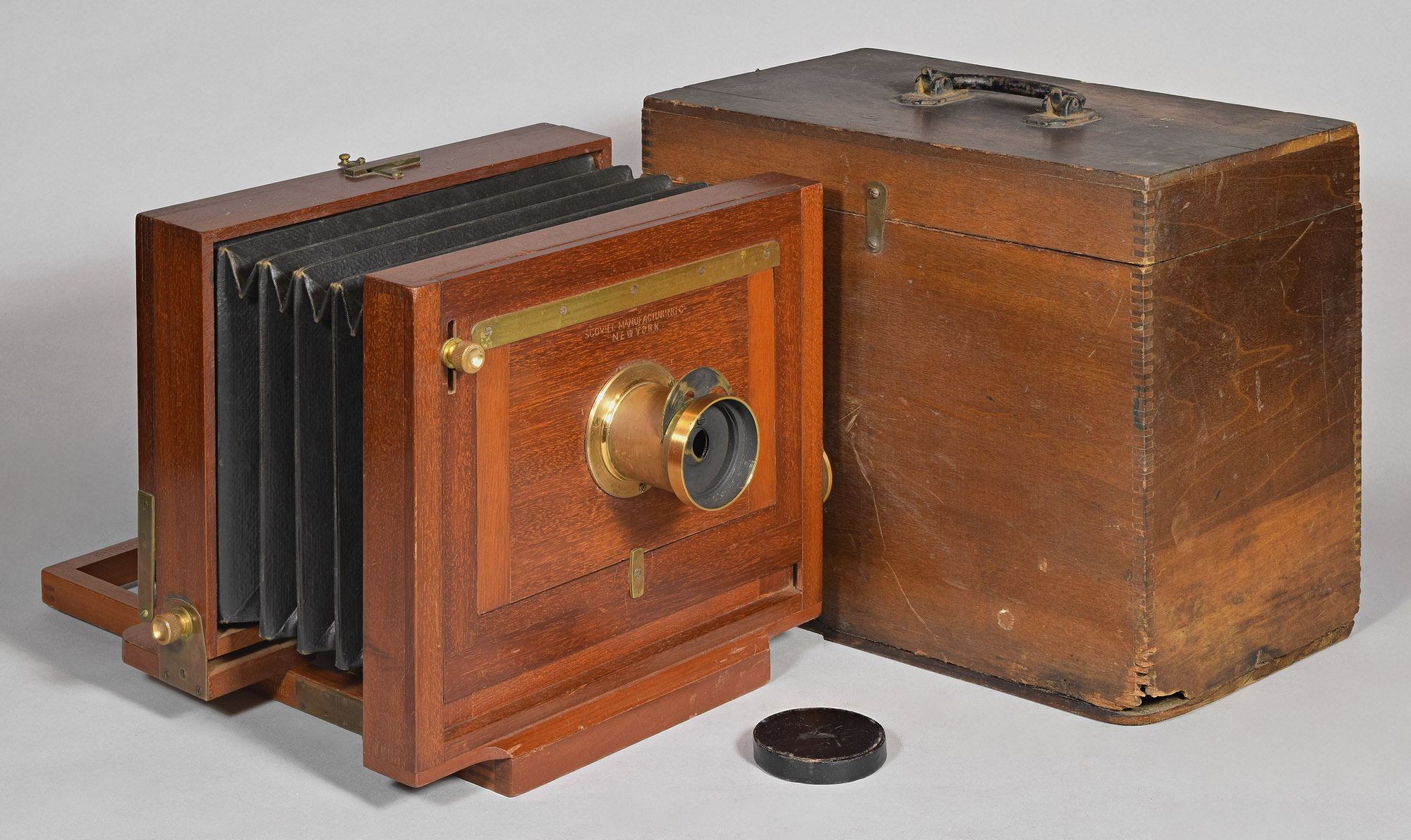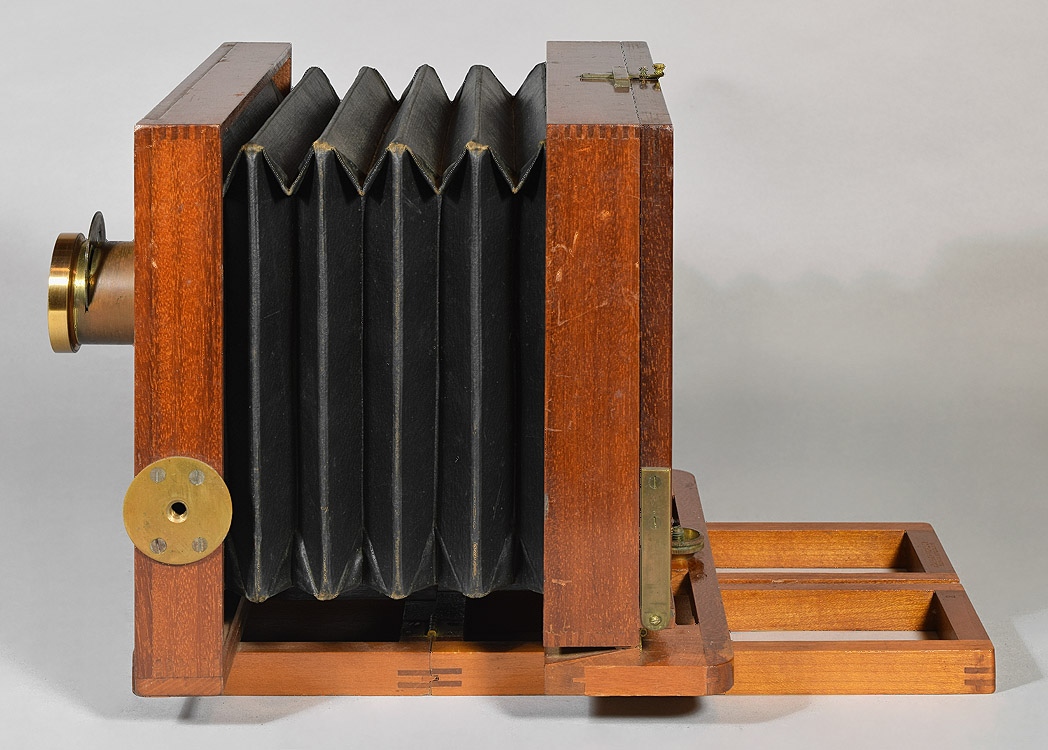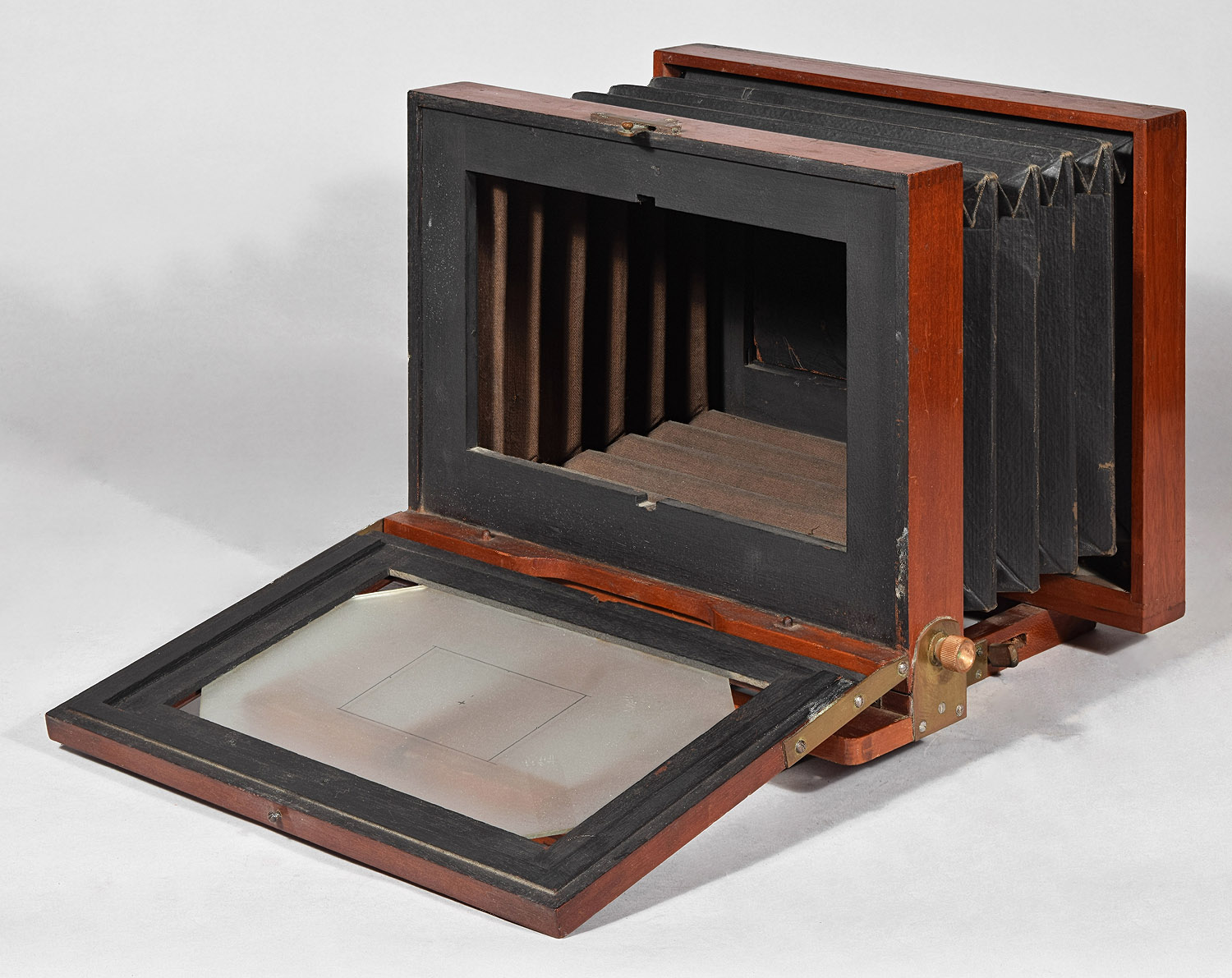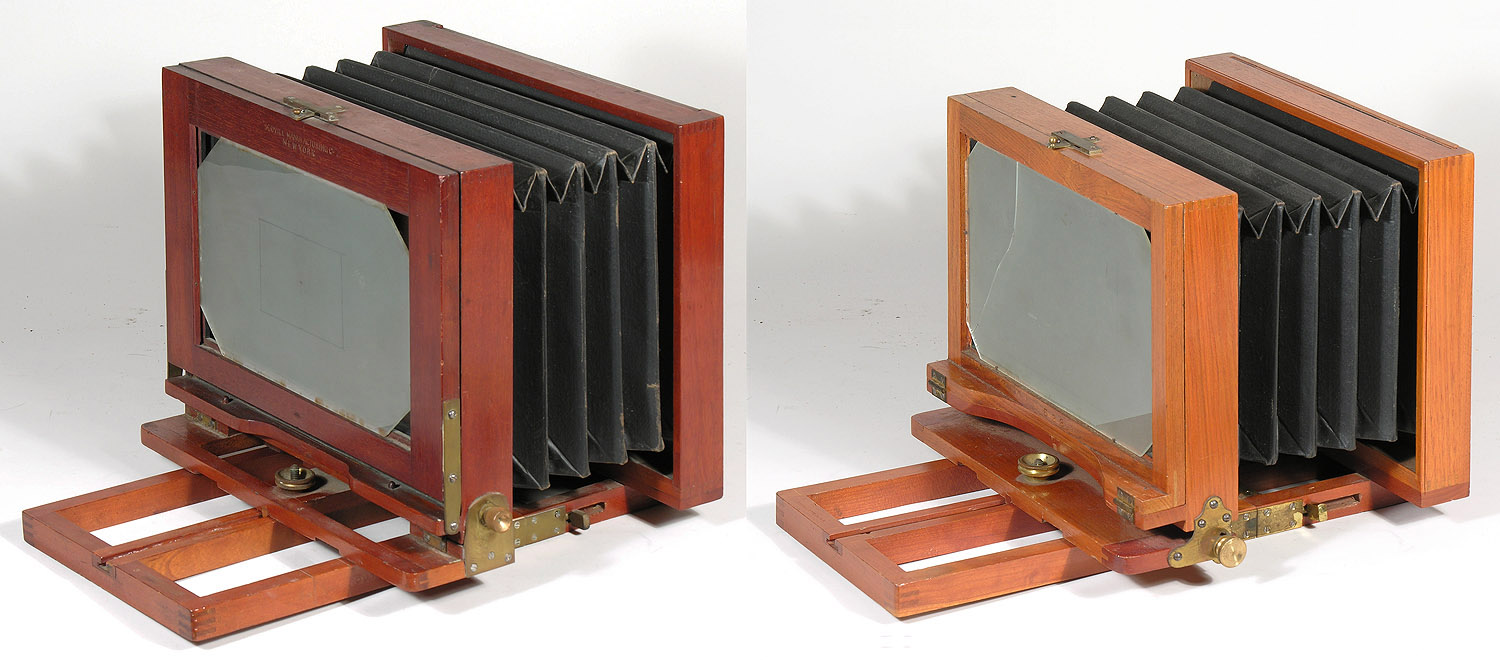American Optical Co., Scovill Mfg. Co., props., New York, NY
Waterbury-Type View Camera Variation 1
Waterbury-Type View Camera Variation 1,
Example: 5x8 ground
glass hinges at sides
A Mixture of Stamps - Scovill Stamps on Lens Board and Ground Glass
Frame, American Optical Stamp on Rear of Platform









Stamp on Lens Board Stamp on Ground Glass Frame Stamps on Rear of Platform Stamp Next to Patent Rod and Piston Device for Making
the Platform Rigid
Another Example of
Waterbury-Type View Camera Variation 1: 5x8 ground
glass hinges at sides Stamp on Lens BoardStamp on Lens Board Stamp on Ground Glass Frame Stamp Next to Patent Rod and Piston Device for Making
the Platform Rigid Date
Introduced: ;
Years Manufactured:
c. 1887?
The
Waterbury View Camera,
named for the Waterbury, CT location of one of Scovill's factories, is
one of the most common Scovill
view
cameras.
There are also Waterbury Detective
Cameras and Waterbury lenses. The Waterbury View
Camera in any of its five variations is basically a Scovill
or American Optical model view camera that has push-pull rear focus,
non-tapering bellows and made from a wood that usually is mahogany.
Specific characteristics of the model and of variations are given below . A table of
characteristics for each example of a Waterbury variation examined is given below.
Scovill Waterbury View Camera Variation 1A:
Scovill Waterbury
View Camera Variation 1
Scovill Waterbury View Camera Variation 2:
American Optical-Type
Waterbury Variations:
American Optical Waterbury-Type View Camera
Variation 1:
American Optical Waterbury-Type View Camera
Variation 2:
Scovill Waterbury & American Optical Waterbury-type Camera
Characteristics
Number
Format
Marked
Type
Serial No.
GG Frame width1
GG Hinge
Swing Hardware
No. of Rod & Piston
Frame/Solid Rear Deck LP1075 5x8 Scovill Mfg. Wat Var 1A 323 0.61 Qtr.-Sawn Sycamore Bottom 2/scalloped
1 Frame LP0006 4x5 Scovill Mfg. Wat Var 1 393 0.60 Light Mahogany Bottom 2/scalloped
1 Solid LP0071 5x8 Scovill Mfg. Wat Var 1 688 0.62 Light Mahogany Bottom 2/scalloped
1 Solid LP0940 4x5 Scovill & Adams Wat Var 1 769 0.58 Light Mahogany Bottom 2/scalloped
1 Solid LP0349 6 x8 Scovill & Adams Wat Var 2 495 0.84 Light Mahogany Bottom 1/square
1 Frame LP626 8x10 Scovill Mfg. Wat Var 2 21 0.82 Light Mahogany? Bottom 2/square
2 Frame LP0521 5x8 Am. Opt. and
Scovill / Both 2 Wat-Type Var 1 None 1.06 Dark Mahogany Side 1/square
2 Frame LP1086 5x8
Am. Opt. and
Scovill / Both 2 Wat-Type Var 1 None 1.06 Dark Mahogany Side
1/square
1 Frame LP748 4x5 Scovill Mfg. Wat-Type Var 2 245 0.59 Dark Mahogany Bottom 1/square
1 Frame LP861 4x5 Scovill Mfg. Wat-Type Var 2 228 .058 Dark Mahogany Bottom 1/square
1 Frame LP894 4x5 Am. Opt., Scovill Wat-Type Var 2 None 0.61 Dark Mahogany Bottom 1/square
1 Frame LP971 4x5 Am. Opt., Scovill Wat-Type Var 2 None 0.62 Dark Mahogany Bottom 1/square
1 Frame LP0572 5x7 Am. Opt., Scovill Wat-Type Var 2 None 0.58 Dark Mahogany Bottom 1/square
1 Frame LP1061 5x8 Am. Opt., Scovill Wat-Type Var 2 None 0.58 Dark Mahogany Bottom 1/square
1 Frame LP1080 5x7 Scovill Mfg. Wat-Type Var 2 22 0.57 Dark Mahogany Bottom 1/square
1 Frame
1
calculated as a ratio of the left frame width to the horizontal
width of the ground glass
2
on both examples, there are two Scovill Mfg. Co., N.Y.
stamps (lens board and ground glass frame) and one American
Optical Co., Scovill Mfg. Co., N.Y. stamps. Comparison of the
size of Waterbury-Type View Camera
Variation 1 to Other Variations (This Example is
Waterbury View Camera Variation 1)
References:
Back to American Optical
Co. / Scovill Mfg. Co. (alphabetical)




The Same Mixture of Stamps
- Scovill Stamps on Lens Board and Ground Glass Frame, American Optical
Stamp on Rear of Platform










Construction:
rear
focus via push-pull;
single swing; reversing by
second tripod mount; three-piece lens
board; ground glass frame is hinged on the sides
Materials:
mahogany body; cherry base; black fabric bellows; brass hardware
Sizes Offered:
at least 5x8 (cut for stereo
septum)
Notes:

(the letters above reference camera parts in
the image to the right)
1) It is back focus only , and has
non-tapering bellows, which results in the front standard being
approximately the same size as the rear standard.
2) The front standard: is a box-jointed square (A), mounted on a ~1/4 bottom
plate (B), the whole screwed to the front of the main platform (C); a
~1/4" thick facing (D) holds the rise mechanism and the lens board.
On the bottom of the front standard, there is
a quarter-round trim linking the vertical standard to the horizontal
platform. The front standard adjusts up or down, held in
place by a male knurled thumbscrew.
3) The rear standard: is a box-jointed square (E), which is not as tall as
the front standard square, mounted to one or sometimes two brass side plates
(F) (the shape of which mainly determine Variation 1 or
Variation 2),
which connect the rear standard to a ~3/8-1/2" sliding platform (G).
The sliding platform runs along the grooved middle of the main
platform, and is secured by a female knurled thumbscrew.
4) The folding platform or bed is hinged, and made rigid by either
a T-shaped thumbscrew (pre-1886) or a rod and piston device (patented by
Mathias Flammang Oct. 20, 1885).
5) The bellows are fabric coated with a black rubberized paint.
6) The ground glass frame hinges down, and is latched up using a
spring-loaded clip which has the same shape and design for all
variations.
7) The Scovill lens board is three piece. The standard lens
was a Waterbury single achromat - early on, it was the insertable
stop
Waterbury Lens Variation 1, later replaced by a the rotating stop
Waterbury Lens Variation 2. However, the lens boards and lenses of
view cameras such as the Waterbury were hardly permanent, and it is
common to find a camera with a replacement lens board and/or a different
lens, even one made by a competitor.
The above shared physical characteristics make all
Waterbury View Cameras and also
what I call Waterbury-type View Cameras look
alike. Variations are defined by the species of wood used and type
of wood finish, the appearance of the brass finish, minor differences in
ground glass frame hinging, and, rarely, a larger size. The
distinguishing characteristics are summarized in the table below.
(the letters above reference camera parts in
the image to the right)
1) It is back focus only , and has
non-tapering bellows, which results in the front standard being
approximately the same size as the rear standard.
2) The front standard: is a box-jointed square (A), mounted on a ~1/4 bottom
plate (B), the whole screwed to the front of the main platform (C); a
~1/4" thick facing (D) holds the rise mechanism and the lens board.
On the bottom of the front standard, there is
a quarter-round trim linking the vertical standard to the horizontal
platform. The front standard adjusts up or down, held in
place by a male knurled thumbscrew.
3) The rear standard: is a box-jointed square (E), which is not as tall as
the front standard square, mounted to one or sometimes two brass side plates
(F) (the shape of which distinguish Variation 1 or
Variation 2),
which connect the rear standard to a ~3/8-1/2" sliding platform (G).
The sliding platform runs along the grooved middle of the main
platform, and is secured by a female knurled thumbscrew.
4) The folding platform or bed is hinged, and made rigid by either
a T-shaped thumbscrew (pre-1886) or a rod and pocket device (patented by
Mathias Flammang Oct. 20, 1885). Patent information is usually
stamped either on the platform next to the device or on the device
itself.
5) The bellows are fabric coated with a black rubberized paint.
6) The ground glass frame hinges down, and is latched up using a
spring-loaded clip which has the same shape and design for all
variations.
7) The Scovill lens board is three piece. The standard lens
was a Waterbury single achromat
(no doubt manufactured in the Waterbury, CT factory)-. Early
lenses would be the insertable
stop
Waterbury Lens Variation 1,
while later lenses would be the rotating stop
Waterbury Lens Variation 2.
It must be remembered, however, that the lens boards and lenses of
view cameras such as the Waterbury were hardly permanent, and it is
common to find a camera with a replacement lens board and/or a different
lens, even one made by a competitor, or a lens board having multiple
sets of screw holes, each set belonging to an installation of a
different lens.
The above physical characteristics are shared by all
Waterbury View Cameras and also
what I call Waterbury-type View Cameras,
which makes them look
pretty much alike. I have defined Variations according to minor
differences, such as the species of wood used, the type
of wood finish (varnish or French-polished shellac), the appearance of the brass finish
(unfinished, partially finished, and/or draw-filed), differences in
ground glass frame hinging, and, rarely, larger or smaller dimensions or size.
The variations are first divided into two broad groups that
appear to have been made in one or the other of the two Scovill
factories. Some Waterbury View
Cameras are hypothesized to have been made in the former
Samuel Peck & Co. factory in New Haven, CT; these examples have less
expensive wood (sycamore), and a varnish finish that requires less time
to finish both the wood and metal. These are called
Scovill-Type Waterbury Variations.
Other cameras appear to be quite similar, but differ in details of
construction, their wood (mahogany) and French polished shellac wood
finish, and draw-filed metal parts - a camera that would have been more
expensive in time and materials than the
Scovill-Type Waterbury Variations. These cameras are
hypothesized to have been made in the American Optical factory in New
York City, NY, and are called American
Optical-Type Waterbury Variations. These variations
are hypothetical, given that the Scovill and Scovill & Adams companies
did not ever indicate that more than one type of
Waterbury View Camera was made;
ads for The Waterbury
consistently name it is The Scovill
Waterbury, never The American
Optical Waterbury, and expensive details such as mahogany
wood, French polish wood finish, and draw-finished metal finish (which
surely would have been mentioned in advertising as they were in ads for
other American Optical products), are never present in
Waterbury View Camera
advertising. Be that as it may, I have bought and examined no
fewer than eight such Waterbury View
Cameras that appear to have been made by American Optical
rather than Scovill. Such cameras were therefore quite common,
despite their apparent lack of advertising. Given this
justification, a careful listing of differences is warranted. The
distinguishing characteristics are summarized in the tables below.
The Waterbury
View Camera Variation 1A has
construction and hardware that are identical to
Variation 1 -
it is thought to be merely the earliest version of Variation 1, due to
the three following features:
1) The wood forming the box-jointed sections of the front and rear
standards is quarter-sawn sycamore, as Scovill also used in two other
early models:
Unknown View Camera
and the
New York View Camera.
The face of the front standard appears to be the same as used in
Variation 1 Waterburys, said in Scovill's catalogs 1887 and after to be mahogany
(albeit a very light-colored mahogany).
2)
The wood near Scovill's piston-type device to make the bed rigid is
stamped with the single word: "Patented", suggesting that the patent had
been applied for but yet to be granted.
Waterbury View Camera
Variation 1 and Waterbury View
Camera Variation 2 have the exact patent date stamped into the
metal of the device itself. Variation 1A would therefore appear to
have been manufactured sometime after the patent, but before the metal
stamps were received.
3)
The wooden case in which the camera came is typical Scovill
spline-joint construction, so has probably been with the camera since
its manufacture. The clasp that fastens the top is an bulky early
style that can also be found on a plate-holding box marked "Sam'l Peck &
Co." from the 1850's or 1860's. This fancy-wood version of the
Waterbury may be an example of
a 1885-1886 Waterbury, made
before the change was made to mahogany.
The
Waterbury View Camera Variation 1 (as well as
Variation 1A) has a scalloped-edged
metal flanges on either side of the rear standard that allow it to tilt
front-to-back. This distinguishes
it from the Waterbury View Camera Variation 2.
The wood, other than the cherry platform wood, is said by Scovill
catalogs to be mahogany starting in 1887. It is a strange, very light-colored, mahogany
that others have called sycamore (which it resembles) and even oak.
Its pores have been left unfilled, then given what appears to be a single coat of
clear shellac, leaving the pores slightly sunken.
This is the most common variant of
The
Waterbury View Camera. It has a somewhat
square-shaped metal flange for tilting the rear standard, which
distinguishes it from the Waterbury Variation 1.
This tilting control flange is only on the right side, and only fastens the tilted rear
standard - the tilting itself is performed by hinges and a small wooden
wedge visible on the left side. This arrangement was undoubtedly
an improvement over
Variation 1,
which tends to become difficult to tighten reliably as the screws that
hold the flanges loosen. Even though there are quite a few extant
Variation 1 cameras, all the engravings in Scovill catalogs appear to be
of Variation 2, even back to
the first catalog to advertise it in 1885. This begs the question of just
when, exactly, were the Variation 1 and
Variation 2 made?
Like the Waterbury View Camera Variation 1,
the Waterbury View Camera Variation 2 is made from a
very light-colored mahogany (except for the cherry platform), finished with a
thin coat of clear shellac.
There exist
Waterbury-design cameras that do
not have the Scovill characteristics listed above. These cameras
may differ from the above
Waterbury cameras in two ways:
1)
The first, most obvious, reason is that some (but not all)
Waterbury
design cameras are marked with an "American Optical, Scovill Mfg. Co.,
Props." stamp in their wood.
I assume, as in the "Scovill"-stamped cameras above, that the stamp is
indicative of the factory in which it was made, in this case, the
American Optical factory in New York City. It is problematical
that some of the cameras having all appearances of having been made in
the American Optical factory are not marked as such, instead being
marked "Scovill Mfg. Co., N.Y." It is possible that some of the
cameras that look like typical American Optical cameras were made in the
New Haven Scovill factory, assuming that the Scovill factory received
the same wood as used in the American Optical factory, and the workers
also received the same training in French polish and draw-file finishing
as their New York City counterparts. However, it is unlikely that
cameras produced in two different factories would be indistinguishable
other than their stamped identification. It is more likely that
Scovill was not vary concerned whether cameras were identified and
stamped as American Optical or Scovill. Their catalogs certainly
are not very clear as to which cameras are American Optical and which
are Scovill. For some models, catalogs identify the maker
(factory), in the June 1891 Scovill catalog, for example: "The
American Optical Star View Camera"
on p.19 or "The
Scovill Manifold Camera" on
p.23. Other models, known to be American Optical due to their
labels, occur adjacent to other identified American Optical models, as
if in an American Optical section of the catalog, in the same June 1891
catalog, for example,
The (Flammang)
Revolving Back Cameras
on pp.20-21 are American Optical products
placed immediately after the
American Optical Star View Camera.
Unfortunately, catalogs appear to shift back and forth from Scovill to
American Optical products. Most unfortunately, neither the catalog
notation nor the catalog position are clear about where the
Waterbury
was made.
2) The second reason, more subtle but nonetheless convincing, is the
physical properties/appearance of the camera. Scovill advertised
certain models as having been specifically manufactured by American
Optical, such as Flammang Revolving Back Cameras (both
Rear Focus and
Front Focus),
The Irving Camera,
The Reversible Landscape Camera,
The "76" or Centennial Camera (and No.s
202-204), Reversible Back Camera (Front
Focus (St. Louis) and Back Focus (Acme)),
The Tourist Pocket Outfit, and
Walmsey's Photomicrographic
Camera. The examination of these models shows the following
characteristics in common:
- The wood is naturally dark mahogany or dark stained mahogany and dark
stained cherry. At a glance, this wood is distinguished from the
light-colored mahogany of the Scovill Waterburys.
- The wood is finished by the process of French polishing: continuing
layers of shellac to fill pores followed by a final buffing to produce a
mirror smooth surface.
- The hardware is nickel-plated or brass finished in what is called a
draw-file finish, producing fine, parallel lines.
- Usually, the screws are lined-up on a side or surface so that their slots are
parallel; subsequent draw filing makes the screws in the same plane as
the hardware that they secure, and makes them almost
invisible.
Since some Waterbury cameras share their physical characteristics with
cameras advertised to have been manufactured in the American Optical
factory in New York City, NY, these Waterburys are presumed to have also
been manufactured in the American Optical factory, and are referred to
here as the
American Optical Waterbury Variation 1
and the
American Optical Waterbury Variation 2.
The hinges on the ground
glass frame are on the bottom of the frame in
Variation 1 and on the sides in
Variation 2.
Variation
2 seems to be very rare, relative to
Variation 1.
Waterbury-Type View Camera Variation 1
has a ground glass frame over 1" wide, whereas all other
Waterbury variations have
frames about ⅝" wide. This makes
Waterbury-Type View Camera Variation 1 significantly larger
than the other variations. The two examples seen so far have an
identical mixture of stamps: Scovill Mfg. Co., N.Y. on the lens board
and on the ground glass frame, and American Optical Co., Scovill Mfg.
Co., N.Y. on the rear of the platform. A comparison of the sizes is shown
just below the table. A Waterbury
having side hinges is never shown in Scovill catalogs or other ads.
This discrepancy in size
between those cameras thought to have been made in the American Optical
factory and those cameras thought to have been made in the Scovill New
Haven factory is similar to the discrepancy found for the variations of
The 76 Camera
(see The 76 Camera
Variation 1 for comparison
photos). The difference in construction may be due to Scovill not
precisely duplicating the tools and jigs used to make the camera in one
factory vs. the other. The company may have merely left
the details of construction to the tool- or camera-makers from each
location. It is not that Scovill cameras are always larger than
American Optical cameras; in The 76
Camera example just mentioned,
The 76 Camera Variation 1are smaller than
The 76 Camera Variations 2 (Wet-Plate Version)
and 3 (Scovill Version).
The hinges on the ground
glass frame are on the bottom of the frame in
Variation 1 and on the sides in
Variation 2.
Variation 2 seems to be very
rare, relative to Variation 1.
Comparison of Construction Features Used
to Determine Scovill Waterbury
and American Optical Waterbury-Type
Variations
Wood
Finish
Hardware Finish
No./Style
Shellac
Plain
Shellac
Plain
Shellac
Plain
Shellac
Plain
Shellac
Plain
Shellac
Plain
French polish
Draw-File
French polish
Draw-File
French polish
Draw-File
French polish
Draw-File
French polish
Draw-File
French polish
Draw-File
French polish
Draw-File
French polish
Draw-File
French polish
Draw-File


